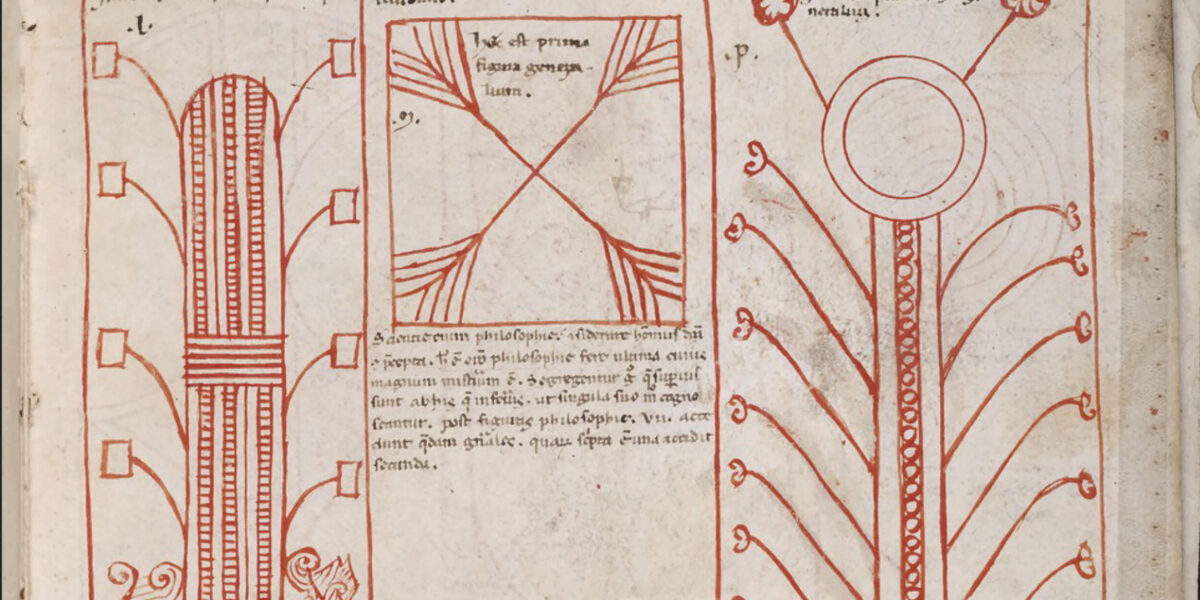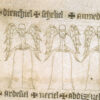by Pseudo-Apollonius of Tyana
Mellon MS 1 | BnF Lat. 7152 | Israel Ms. Yah. Var. 34 | BnF Latin 7153 | BnF Latin 9336
The Ars Notoria (or Notary Art) is not only the oldest portion of the Lemegeton but one of the oldest grimoires in the Solomonic tradition of magic. The work has been pseudepigraphically attributed to prominent figures such as Euclid of Thebes and King Solomon. As for the later, God gave the book to Solomon through the hand the Angel Pamphilius who in turn passed it to its supposed translator, the magician, Apollonius of Tyana.
It contains a series of invocations to be spoken while fixating upon a set of intricate and complex drawings (or Notae) that enable the practitioner to learn at an accelerated rate and quickly comprehend complex subjects as would one if they had an eidetic and photographic memory.
The Ars Notoria is included in some editions of the Lemegeton. Those that do, follow Robert Turner’s 1657 English edition, which is evidently his own translation from its first Latin appearance in Agrippa’s Opera Omnia (ca. 1600). Neither edition included the most vital component of its operation, the Notae, which in its absence, renders the entire system inoperable.
For comparison, I have included both the Robert Turner text and facsimiles of five original manuscripts that include the Notae. The first manuscript is the earliest known manuscript of the Ars Notoria, (Yale University’s Beinecke MS Mellon 1). This manuscript is attributed to the magician Apollonius of Tyana who called it Flores aurei, or the Golden flowers. The second manuscript is also attributed to Apollonius of Tyana, Apollonius, Flores aureos ad eruditionem et cognitionem omnium scientiarum et naturalium artium. It is preserved at The Bibliothèque nationale de France and was written in the 14th century. The third manuscript, Liber de Arte Memorativa, belonged to Simon Forman (1552-1610), an astrologer, active in London during the reigns of Queen Elizabeth I and James I. Its preserved at the the National Library of Israel, Jerusalem, Israel and dates from the mid-16th century. The last two are both in the The Bibliothèque nationale de France, Liber cujus is est titulus: Sacratissima ars notoria written in the 15th century and Sacratissima ars notoria written soke time in the 14th century.
I. Ars notoria, sive Flores aurei:
Description: Script: Neatly written in Gothica Textualis, mostly very regular and small, sometimes minute, with various additions by similar and later hands. Capitals in red, blue, or green at paragraph beginnings, mostly plain, but some with slight extensions; a large capital in red and blue with green tracery at beginning. Diagrams and drawings in red ink, mostly accompanied by text in brown, often with the text forming a part of the design, on parts or all of ff. 10v-17v. Binding: Wrapper, probably modern, consisting of a piece of old parchment, perhaps cut from the blank portion of a large document with a fold and some slits, the modern sewing penetrating the back
Abstract: Fifteen pages of largely diagrammatic drawings, approximately thirty-six in all, depending on how their relationships are interpreted (the text calls for thirty-two), are found from f. 10v to f.17v, most of them accompanied by labels and the texts of prayers consisting of long series of invented names with exotic sounds written in a minute hand in brown ink, while the designs themselves are throughout in red. The text of the manuscript also includes numerous prayers, some of them consisting of exotic names. Manuscript on parchment of Apollonius, Ars notoria, sive Flores aurei. A text in which a direct approach to knowledge is sought by means of incantation. The text of the manuscript also includes numerous prayers, some of them consisting of exotic names.
II. Apollonius, Flores aureos ad eruditionem et cognitionem omnium scientiarum et naturalium artium:
Description: F. 1-22. Ars notoria: “Expositiones quas Magister Apollonius Flores aureos ad eruditionem et cognitionem omnium scientiarum et naturalium artium generaliter et merito et competenter appellavit. Hoc [opus] Salomonis Machinei et Euclidii actoritate maxima compositum et probatum est.” (éd. crit. J. Véronèse, op. cit., ms. P). The upper cover bears the mention, “Expositiones Apollonii ad cognitionem scientiarum Quas Flores aureos appellavit.”
Binding: Parchment. – 22 ff. – 23 figures in full page (f. 11v-22v)
III. Liber de Arte Memorativa:
Format: Thick brownish parchment. Margins: 40, 52, 18, 44 mm. Bounding lines: 2, 2, 2, 2 vert., 2 and 2 hor. in red ink. Text space 426 x 368 mm. 3 cols., 94 lines, written in brown, one hand. Two foliations. First is original, in red and brown ink. Second foliation is modern. Some pages are paginated. Catchwords. Collation: I2 first is used as pastedown, II-VII4 4 is partly thorn away, VIII4 last is used as pastedown. Decoration: 35 illustrations in ¾ of page. 3-6-line red initials, red rubrics.
Binding: 520 x 437 mm. Original yellow limp dirty binding, sewn on 5 thongs. In the binding is seen a paper leaf from some musical ms.
Ownership History: In 1600, the MS belonged to Simon Forman (1552-1610), an astrologer, active in London during the reigns of Queen Elizabeth I and James I. At the front pastedown appears an ex libris of George Wrighte of Gothurst.
IV. Liber cujus is est titulus: Sacratissima ars notoria
Full Title: liber cujus is est titulus : Sacratissima ars notoria, quam Creator altissimus per Angelum suum super altare templi quadam nocte Salomoni, dum oraret, ministravit ; ut per eam omnes scientias liberales, mechanicas et exceptivas, et earum facultates per breve spatium temporis posset acquirere et habere ; et in proferendo mystica verba sanctarum orationum, et invocando nomina sanctorum Angelorum, quae in ea continentur, in omni scientia ac sapientia penitùs fundaretur ; accedunt figurae : porrò hoc opus nihil aliud est quàm praecedens cum commentario.
Format: Parchment
V. Sacratissima ars notoria:
Format: 28 ff. – Paintings. – 440 × 290 mm. – Binding in rooted calfskin on red skin with Louis XVIII cipher, [Lefebvre] July 29, 1819; cf. B. n. F., Manuscripts department, Archives Modernes 624




